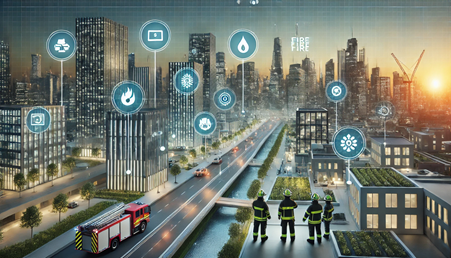
The fire protection industry is undergoing significant changes in 2025, driven by advancements in technology, evolving regulations, and a growing emphasis on sustainability. Here’s a detailed look at the key fire protection trends, organized by numbering for clarity:
- Integration of Smart Technologies
Smart technologies, powered by the Internet of Things (IoT) and artificial intelligence (AI), are revolutionizing fire protection systems. These advancements allow for:- Real-time monitoring and remote management of fire systems.
- Integration with other building systems like HVAC and security.
- Predictive maintenance and enhanced risk assessment through AI-driven analytics.
- Emphasis on Sustainability
Environmental sustainability is becoming a central focus in fire protection:- Traditional fire suppression agents are being replaced with eco-friendly alternatives, such as water mist systems and biodegradable foams.
- Fire protection systems are now designed for energy efficiency, contributing to greener building initiatives.
- Advanced Fire Detection Systems
Fire detection technology has evolved to provide faster and more accurate detection:- Multi-sensor detectors that combine smoke, heat, and carbon monoxide detection are becoming standard.
- Video-based fire detection systems use AI to analyze visual data for early signs of fire, especially useful in large or complex environments.
- Enhanced Building Codes and Standards
Building codes and fire safety standards are being updated to reflect modern fire risks:- Stricter regulations focus on fire-resistant building materials and enhanced safety protocols.
- New codes often incorporate the latest research and technological advancements, ensuring buildings are better prepared for fire incidents.
- Focus on Wildfire Prevention and Mitigation
Given the rising frequency of wildfires, there is increased attention on:- Early warning systems like satellite-based detection.
- Fire-resistant materials for buildings in high-risk areas.
- Community-wide strategies such as controlled burns and vegetation management to prevent the spread of wildfires.
- Firefighter Safety and Equipment Innovation
Protecting firefighters is a priority, leading to innovations in:- Lightweight, heat-resistant protective gear.
- Wearable technology that monitors vital signs and environmental conditions, providing real-time data to enhance safety during firefighting operations.
- Data-Driven Fire Risk Management
Data analytics are playing a crucial role in fire risk management:- Comprehensive data from fire incidents, maintenance records, and environmental conditions help in identifying trends and predicting fire risks.
- This proactive approach allows for targeted fire prevention measures and better resource allocation.
- Expansion of Remote Fire Protection Services
Remote services, accelerated by the COVID-19 pandemic, continue to expand:- Remote inspection and maintenance services leverage advanced diagnostic tools, reducing the need for on-site visits.
- These services ensure optimal functioning of fire protection systems through real-time data and remote diagnostics.
- Increased Public Awareness and Education
Public education on fire safety is gaining more attention:- Digital platforms, social media, and interactive training programs are being used to raise awareness and educate the public on fire prevention measures.
- Increased public engagement in fire safety practices contributes to overall community resilience.
- Resilient Infrastructure Design
The concept of resilient infrastructure is becoming more prevalent:- Buildings and communities are being designed to withstand and quickly recover from fire incidents.
- This involves the use of fire-resistant materials, strategic landscaping, and comprehensive fire management plans, aiming to minimize fire impact and ensure community safety.
Conclusion
The fire protection industry in 2025 is marked by technological innovation, a commitment to sustainability, and proactive risk management strategies. With these trends, the industry is better equipped to handle evolving fire threats, ensuring safer environments and more resilient communities. By adopting these advancements, stakeholders can stay ahead of the challenges and contribute to a safer, more sustainable future.





Leave A Comment